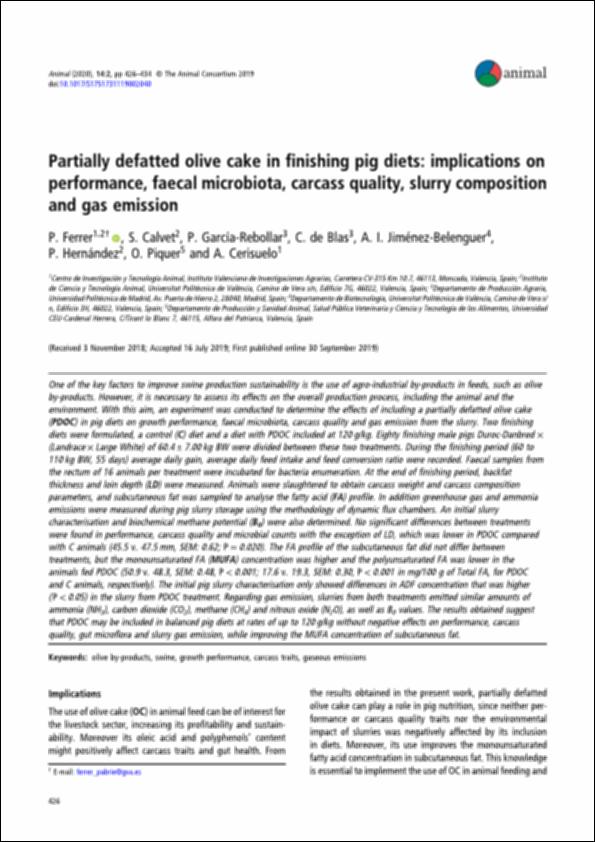Please use this identifier to cite or link to this item:
http://hdl.handle.net/10637/12458Partially defatted olive cake in finishing pig diets : implications on performance, faecal microbiota, carcass quality, slurry composition and gas emission
| Title: | Partially defatted olive cake in finishing pig diets : implications on performance, faecal microbiota, carcass quality, slurry composition and gas emission |
| Authors : | Ferrer Riera, Pablo Calvet Sanz, Salvador García Rebollar, Paloma Blas Beorlegui, Carlos de Jiménez Belenguer, Ana Isabel Hernández Pérez, María del Pilar Piquer Querol, Olga |
| Keywords: | Swine - Breeding.; Swine - Feeding and feeds.; Cerdos - Alimentación.; Gases - Environmental aspects.; Cerdos - Cría y explotación.; Gases - Aspectos ambientales. |
| Publisher: | Elsevier |
| Citation: | Ferrer, P., Calvet, S., García-Rebollar, P., De Blas, C., Jiménez-Belenguer, I.A., Hernández, P., et al. (2020). Partially defatted olive cake in finishing pig diets : implications on performance, faecal microbiota, carcass quality, slurry composition and gas emission. Animal, vol. 14, i. 2 (feb.), pp. 426-434. DOI: https://doi.org/10.1017/S1751731119002040 |
| Abstract: | One of the key factors to improve swine production sustainability is the use of agro-industrial by-products in feeds, such as olive by-products. However, it is necessary to assess its effects on the overall production process, including the animal and the environment. With this aim, an experiment was conducted to determine the effects of including a partially defatted olive cake (PDOC) in pig diets on growth performance, faecal microbiota, carcass quality and gas emission from the slurry. Two finishing diets were formulated, a control (C) diet and a diet with PDOC included at 120 g/kg. Eighty finishing male pigs Duroc-Danbred × (Landrace × Large White) of 60.4 ± 7.00 kg BW were divided between these two treatments. During the finishing period (60 to 110 kg BW, 55 days) average daily gain, average daily feed intake and feed conversion ratio were recorded. Faecal samples from the rectum of 16 animals per treatment were incubated for bacteria enumeration. At the end of finishing period, backfat thickness and loin depth (LD) were measured. Animals were slaughtered to obtain carcass weight and carcass composition parameters, and subcutaneous fat was sampled to analyse the fatty acid (FA) profile. In addition greenhouse gas and ammonia emissions were measured during pig slurry storage using the methodology of dynamic flux chambers. An initial slurry characterisation and biochemical methane potential (B0) were also determined. No significant differences between treatments were found in performance, carcass quality and microbial counts with the exception of LD, which was lower in PDOC compared with C animals (45.5 v. 47.5 mm, SEM: 0.62; P = 0.020). The FA profile of the subcutaneous fat did not differ between treatments, but the monounsaturated FA (MUFA) concentration was higher and the polyunsaturated FA was lower in the animals fed PDOC (50.9 v. 48.3, SEM: 0.48, P < 0.001; 17.6 v. 19.3, SEM: 0.30, P < 0.001 in mg/100 g of Total FA, for PDOC and C animals, respectively). The initial pig slurry characterisation only showed differences in ADF concentration that was higher ( P < 0.05) in the slurry from PDOC treatment. Regarding gas emission, slurries from both treatments emitted similar amounts of ammonia (NH3), carbon dioxide (CO2), methane (CH4) and nitrous oxide (N2O), as well as B0 values. The results obtained suggest that PDOC may be included in balanced pig diets at rates of up to 120 g/kg without negative effects on performance, carcass quality, gut microflora and slurry gas emission, while improving the MUFA concentration of subcutaneous fat. |
| Description: | Este artículo se encuentra disponible en la siguiente URL: https://www.sciencedirect.com/science/article/pii/S1751731119002040?via%3Dihub En esta investigación también participan: S. Calvet, P. García-Rebollar, C. de Blas, A.I. Jiménez-Belenguer, P. Hernández, O. Piquer y A. Cerisuelo. |
| URI: | http://hdl.handle.net/10637/12458 |
| Rights : | http://creativecommons.org/licenses/by-nc-nd/4.0/deed.es |
| ISSN: | 1751-7311 1751-732X (Electrónico). |
| Issue Date: | 21-Feb-2020 |
| Center : | Universidad Cardenal Herrera-CEU |
| Appears in Collections: | Dpto. Producción y Sanidad Animal, Salud Pública Veterinaria y Ciencia y Tecnología de los Alimentos |
Items in DSpace are protected by copyright, with all rights reserved, unless otherwise indicated.


